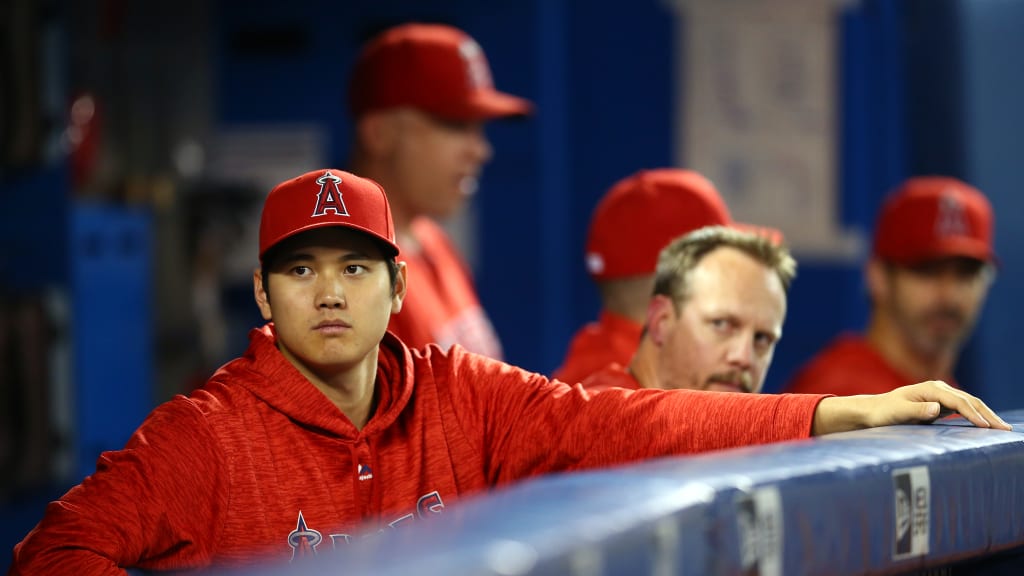
The Angels have made it clear that they view Shohei Ohtani as a two-way player and that he’ll return to pitching in 2020 after undergoing Tommy John surgery on Oct. 1 of last year. But with his immense offensive talent and his injury history, it’s fair to wonder if it that stance might change at some point, with the club having him focus on being a full-time offensive force.
Angels manager Brad Ausmus downplayed that possibility this week, as Ohtani has continued his throwing program and is nearing throwing off a mound for the first time since surgery. Ohtani has also stated his desire to remain a pitcher.
“I’d rather have him do both," Ausmus said. "I’ll take that pitcher on the mound every sixth day or so as well."
Ohtani’s offensive production, however, does make it at least something that’s worth exploring, as the club obviously wants to get as much production from Ohtani before he’s eligible to become a free agent after the 2023 season.
This year, Ohtani started off slow, but he regained his timing and has picked it up in recent weeks. He’s hitting .276/.341/.493 with nine homers in 36 games after batting .285/.361/.564 with 22 homers in 104 games last year when he won the American League Rookie of the Year Award.
Add it up, and the 23-year-old has a .282/.354/.542 line with 31 homers in 537 career plate appearances, basically the equivalent of a full season. Those numbers reflect a star-level hitter.
With that in mind, here’s a look at the pros and cons of Ohtani being a full-time position player versus his value as a two-way player who pitches roughly once a week and serves as DH three-to-four times a week.
The case for keeping him a two-way player
Ohtani is the club’s best pitcher. He posted a 3.31 ERA with 63 strikeouts, 22 walks and six homers allowed in 51 2/3 innings last year before suffering a full tear of the ulnar collateral ligament in his pitching elbow, which forced him to undergo Tommy John and prevent him from pitching this season.
The Angels also won the bidding to bring Ohtani from Japan based on their promise to allow him to both hit and pitch, which is becoming an organizational trend. The club has several other two-way players in the system including Jared Walsh, Kaleb Cowart, William English, Bo Way and the recently-drafted Erik Rivera. They have really been leaning into the two-way player concept perhaps more than any other club, so not allowing the poster boy for two-way players stop pitching would create a bit of a disconnect.
Ohtani’s routine last year was to mostly start on Sundays, and he’s expected to stick to that schedule next year to limit his innings because he’s coming off the surgery. If he starts once a week and makes every start during a season, it would give him 26 outings, which isn’t too far off the 30-34 starts that healthy pitchers make over the course of a season.
Having Ohtani essentially as a sixth starter also gives the Angels more flexibility with the rest of their rotation and can help the club be cautious with its innings for its young starters, such as Griffin Canning and Jose Suarez, who both figure to be a huge part of the club’s future.
The franchise also has postseason aspirations in 2020 and beyond, and Ohtani would certainly be counted on to be a starter in a playoff series, and the extra off days in October would probably allow him to hit or pitch in pretty much every game, which he can’t really do as a two-way player during the regular season.
The Angels could also get creative with the way they use Ohtani in both an effort to limit his innings and to get him more at-bats offensively. He could be used in relief -- or possibly even as an opener or closer -- in certain situations instead of being a full-time starter.
If he ever returns to right field, a position he hasn’t played since 2014, Ohtani could even serve as a reliever late in games without the club having to lose the DH. It’s similar to what they’ve done with Walsh at Triple-A Salt Lake, as he’s moved from first base to pitch late in a few games over the past two seasons.
Why make him just a position player?
Ohtani has already developed into an elite slugger and he could play every day if he doesn’t pitch. Last year, Ohtani didn’t serve as DH the day before, the day of and the day after his starts, which limits his impact offensively.
There’s also less injury risk to his elbow as a position player. If he suffers a setback while pitching, it would likely keep him out of action as both a pitcher and a hitter, and the Angels can’t afford to lose Ohtani to a long-term injury. Tommy John has a high rate of success, but there are no guarantees.
MLB's new two-way rule that goes into effect next year also hurts Ohtani because he's not pitching this year. Clubs will have to designate players as either pitchers or position players next season, and the number of pitchers will be capped. There is a two-way designation, but Ohtani won't qualify until he reaches 20 innings and 20 games as a DH. Until then, Ohtani will count against the Angels' pitcher total, limiting their roster flexibility early in the year. Once a player attains two-way status, his club essentially gains an extra pitcher.
If Ohtani doesn’t pitch, he could also be freed from only serving as DH, as he did play some right field in Japan. His speed and strong arm would profile well there.
The Angels, though, do have a crowded outfield, with the club holding an option on Kole Calhoun for 2020 and top prospect Jo Adell on the way to join Mike Trout and Justin Upton. So the Angels don't exactly have a huge need in the outfield, but playing Ohtani there would increase his versatility and allow club to continue to use Albert Pujols -- who is signed through 2021 -- as a DH and still have Ohtani’s bat in the lineup.
And that’s really the thing: Keeping Ohtani’s bat in the lineup should be a high priority for the Angels, as he has established himself as the second-best hitter on the team and legitimately one of the best in MLB.
His 143 wRC+ since the start of the 2018 season ranks 12th in MLB in that span (min. 500 total PAs), ahead of superstars such as Ronald Acuna, Jr., Manny Machado, George Springer, Kris Bryant, Paul Goldschmidt, Nolan Arenado and many more. There is no disputing the fact that Ohtani is an elite hitter.
Furthermore, due to a left ankle sprain in 2017 that kept him off the mound for most of the year for the Nippon Ham Fighters (as well as the elbow injury preventing him from pitching this year), Ohtani will enter the 2020 campaign having pitched just 77 innings over his previous three seasons.
It’s hard to see a scenario where he can be counted on for a heavy workload on the mound next season given those limited innings the past three seasons. And if kept off the mound, his chances of injury are reduced significantly.
Bottom line: Ohtani the two-way player is a phenomenon, but it’s easy to see the possible benefits of him exclusively focusing on hitting.
